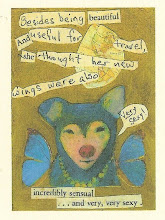Honorine de Brabant, a Bourbon Rose.
I've been waiting for this gorgeous bloom for one year.
You've seen roses like her in the paintings of the old masters.
Honerine is full of buds, and I'll be
photographing her again later in the week.
This flower is cupped, striped and fragrant.
An unforgettable combination.
These Lady Banks blooms cover a huge rambling plant.
The flowers aren't very fragrant (if at all),
and the Spring only blooms are each the size of a penny.
But she makes a gigantic display.
I remember my Grandmother Gray's rose garden. It was in a sunny side yard, along the road where everyone in the neighborhood could enjoy it's colors and scent.
With long stems and long lasting blooms perfect for picking, most of Grandmamma's roses were modern Tea roses or Floribundas. Being a teenager, I didn't understand her love for roses, but was delighted that my grandmother had that rose garden, because it always gave me a ready idea for Mother's Day.
A handful of sweetly scented elegance,
mostly Madame Pierre Oger,
but a sample of all blooming in our garden today.
On my 16th birthday, Grandmamma picked 16 different roses and presented them to me in a Mason jar; it was one of my most treasured gifts, ever. With all the colors, shapes and scents in one place, I acquired a new appreciation for the elegant, yet humble rose.
Champney's Pink Cluster, a Noisette, has grown thru her friend,
Lady Banks (a yellow species rose)
and is now thriving above the Lady's head.
Champney's Pink Cluster was first grown in Charleston.
I was going to dig her up after the 3rd year, when she was
leafless, thanks to a bad case of blackspot.
Then she discovered her wild but accommodating neighbor.
Turns out, that's how she grows best.
Bill showing off for the Lady and me.
Grandmamma would be proud to learn that I, too, am a rose grower. My first love, however, are the old roses; the Bourbons, Noisettes, Mosses, Damasks, Rugosas and other very fragrant roses.
Madame Pierre Oger
This rose has the most incredible scent.
I picked most of these because she's not in a
good location for me to enjoy.
Contrary to what many people think, though they can be hard to find, old roses need not always be a costly purchase. It is true that many antique roses are rare, and must be obtained through nurseries that specialize in old roses.
I bought most of my collection through inexpensive sources. This has it's advantages:
1.
Cheap. I have paid no more than $5.00 for many of my old roses. If you can't afford to buy perfect specimens from garden stores and online shops, you can still acquire a limited selection of beautiful roses for low prices.
2.
Readily available. In my area, old roses are hard to find in nurseries. There are many reputable sources which guarantee quality and assure that the rose you are buying is actually the rose you think you are buying. But often you have to wait for the rose to be rooted, and then shipped. (Though it's well worth it for a special, rare bloom.)
Rose de Rescht, my wonderfully scented
Damask, is infected with a mosaic virus,
as evident in the yellow patterning on the leaves.
Purchasing discount bare root roses has disadvantages:
1.
Questionable quality. Though they may be perfectly fine, when you're buying from discount stores there is no guarantee that you aren't buying a rose infected with a virus. This may or may not affect the bloom, and though it isn't contageous, it may be unsightly. It will most certainly keep you from winning a prize at the local Rose Society.
2.
Questionable variety. I'm glad to see that my Champney's Pink Cluster is actually what it was labeled to be. The same with my $5.00 Home Depot roses. But the roses I bought this year from (...I don't even want to tell you where I got them!) a cheap place?
Climbing Fourth of July
This rose came from a nursery. It isn't an "old rose"
but is gorgeous, combining some of
my favorite old rose qualities, like scent, a yellow center,
the single bloom, and a deep red stripe.
When I bought them, I knew that one of these discount roses wasn't what it was supposed to be. I could tell because of the strangely prickly, dark stems and deeply grooved leaves. It's going to be either a rugosa or moss. Since I love both of those, I took my chances and bought it.
Our newest Mystery Rose:
With this black, prickly stem, I knew this wasn't
a properly labeled rose. Bill and I decided
that for $3.33, it was worth the risk. If it's a Rugosa which suckers,
it will have to be moved in the fall.
But as the other roses from that purchase acquire their leaves, I'm realizing that their leaves are all different even though four of them were supposed to be just two certain roses. I'll have to wait for the first big bloom to be able to identify them, and even then it might be impossible. Plus, they might be Teas or some new varieties, which are lovely, but not what I'm looking for.
But don't worry about our little garden, my friend. The thing about Mystery Roses is that they can be moved and relocated, or even given away. It's a little trouble, but it's worth it...I hope...
One bit of advice for planting bare root roses: buy them as soon as you see them in the store and plant them the right way (I talk about this in a previous post) right away.
Have a rosey day, my friend!
An Honorine de Brabant bloom, fully open.
Below are some links to various rose sources and information:
http://www.antiqueroseemporium.com/
http://http//www.vintagegardens.com/
http://www.heirloomroses.com/
http://www.rose.org/
http://www.ars.org/
Books on Old Roses and Antique Roses (Many of these are out of print, but can be found through Amazon and other on-line sources):
100 Old Roses for the American Garden (Smith & Hawken) by Clair G. Martin (my favorite)
The Random House Book of Old Roses by Roger Phillips
The Fragrant Year, Scented Plants for Your Garden by Helen Van Pelt Wilson (out of print and no pictures, but my sister Jeanie's favorite)
Best Rose Guide: A Comprehensive Selection by Roger Phillips and Martyn Rix
PS: Later this week I'll show you how to root a rose (or other plant) cutting. I also want to talk about potted herbs. See you then.















































